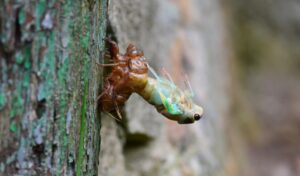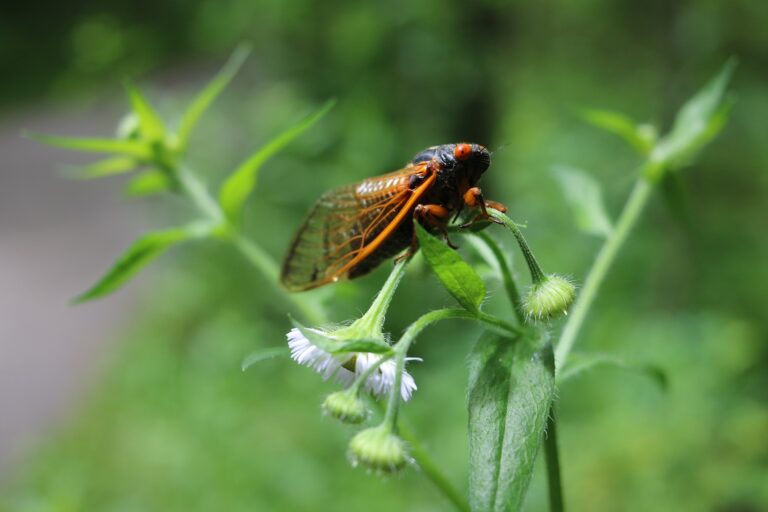Cicadas have been highly visible, with sightings from different suburbs in Chicago like Downers Grove, Oak Park, Palos Park, Park Forest, Lake Forest, and Highland Park. An example is a recent video from Wilmette showing a tree swamped with cicadas. These insects have been buzzing for weeks across communities and are now reaching their life cycle’s end stage.
Professional Forecasts
Dr. Gene Kritsky from Mount St. Joseph University has been monitoring cicada appearance in both Illinois and throughout the US. He suggests that cicada activity might go on until mid-June at least. “Adults will still make loud sounds until mid-June then start reducing by June end,” he stated.
In an interview held on May 29th, Dr. Kritsky mentioned that cicadas might keep showing up for another week or so and gradually reduce during the first week of June. That said, the noise and observations will go on as cicadas finish their aboveground life cycles.
Life Span and Life Cycle of Cicadas
Cicadas live about four weeks approximately. Therefore places plagued by high numbers should see a noticeable decrease shortly. The Smithsonian National Museum of Natural History states that emergence usually lasts between three to four weeks.
The Department of Natural Resources Illinois says an adult periodical cicada’s lifespan is roughly a month., while Purdue University suggests that they would fade away a month and a half after initial emergence.
Substantial Reasons for Emergence
Based on molecular and temperature related factors, cicadas come out. Dr. Kritsky shares that their emergence is likely connected to the annual cycles of their host trees. Also, high temperatures are essential. For instance, around May 18th and 19th weekend, warmer weather probably led to a sizable rise in cicada emergence as ground temperatures hit 64 degrees.
The Difference in Cicada Emergence
The process of emergence can be uneven. “Note that they only emerge from below trees,” mentioned Kritsky. Areas with heavy tree coverage where cicadas have laid eggs in the past might experience a strong emergence. However, urban growth and farming activities that cut down tree cover can restrict cicada numbers
Simultaneous Appearance of Brood XIII and Brood XIX
The 2024 cicada appearance marks history due to two broods. Brood XIII and Brood XI emerging at once. These broods are on 17-year and 13-year cycles respectively but haven’t surfaced together for over two centuries. This unprecedented spectacle is being observed mostly in Illinois, acting as the epicenter for it. The unique synchronization of these broods intensifies current cicada activity.
People’s Attitude and Environmental Effect
Cicadas loud mating calls in wooded locations have made them a popular discussion topic. Although some people find them irksome, they are important for our ecosystem.
Cicadas provide food for birds amongst other wildlife, perform lawn aeration duties, better water filtration processes, and contribute nutrients as they decompose.
The influx of nutrients from their decomposing bodies even benefits land and water ecosystems.
Facing the Cicada Issue Creatively
Illinois residents have come up with original responses to the cicada explosion. A woman amusingly recorded a “day in the life” of a cicada using photos.
Citizen scientists are also aiding in tracking cicada activity. Dr. Kritsky has developed the Cicada Safari app that allows users to post pictures of cicadas to assist in mapping their current emergence. Amazingly, this app received over 561,000 verified cicada photos during the 2021 Brood X emergence.
Conclusion
We’re nearing cicada season’s end, but their presence will be felt for at least few more weeks. According to Dr. Kritsky and other professionals, by mid to late June, these insects would’ve completed their life cycles. Illinois inhabitants can expect lessening noises going forward.
The appearance of these insects is exceptional natural phenomenon everyone should marvel and respect regardless of them being potentially problematic at times. As remarked by Dr.Kritsky,”This is an amazing natural phenomenon to wonder about, not something to be afraid of.”. So, Cicadas may seem overwhelming due to their noise but they play a crucial role in our ecosystem causing advantages that surpasses minor disturbances.











+ There are no comments
Add yours